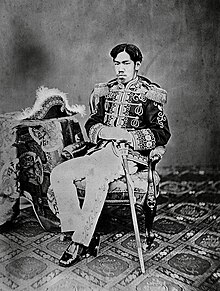
Back Meiji Afrikaans الإمبراطور ميجي Arabic الامبراطور ميجى ARZ Meiji Tennō AST Meyci Azerbaijani Император Мэйдзи Bashkir Імператар Мэйдзі Byelorussian Мейджи Bulgarian সম্রাট মেইজি Bengali/Bangla Emperador Meiji Catalan
| Emperor Meiji 明治天皇 | |||||||||
|---|---|---|---|---|---|---|---|---|---|
 Portrait by Uchida Kuichi, 1873 | |||||||||
| Emperor of Japan | |||||||||
| Reign | 30 January 1867 – 30 July 1912 | ||||||||
| Enthronement | 13 February 1867 | ||||||||
| Predecessor | Kōmei | ||||||||
| Successor | Taishō | ||||||||
| Shōgun | Tokugawa Yoshinobu (1866–1868) | ||||||||
| Daijō-daijin | Sanjō Sanetomi (1871–1885) | ||||||||
| Born | Mutsuhito, Prince Sachi (祐宮睦仁親王) 3 November 1852 Kyoto Gyoen National Garden, Kyoto, Yamashiro, Tokugawa shogunate | ||||||||
| Died | 30 July 1912 (aged 59) Meiji Palace, Tokyo City, Tokyo Prefecture, Japan | ||||||||
| Burial | 13 September 1912 | ||||||||
| Spouse | |||||||||
| Issue among others... | |||||||||
| |||||||||
| House | Imperial House of Japan | ||||||||
| Father | Emperor Kōmei | ||||||||
| Mother | Nakayama Yoshiko | ||||||||
| Religion | Shinto | ||||||||
| Signature | |||||||||
Mutsuhito[a] (3 November 1852 – 30 July 1912), posthumously honored as Emperor Meiji,[b][c] was the 122nd emperor of Japan according to the traditional order of succession, reigning from 1867 until his death in 1912. His reign is associated with the Meiji Restoration of 1868, which ended the Tokugawa shogunate and began rapid changes that transformed Japan from an isolationist, feudal state to an industrialized world power. Emperor Meiji was the first monarch of the Empire of Japan, and presided over the Meiji era.
At the time of Mutsuhito's birth, Japan was a feudal and pre-industrial country dominated by the isolationist Tokugawa shogunate and the daimyō subject to it, who ruled over Japan's 270 decentralized domains. The opening of Japan to the West from 1854 fueled domestic demands for modernization, and when Mutsuhito became emperor after the death of his father Emperor Kōmei in 1867, it triggered the Boshin War, in which samurai (mostly from the Chōshū and Satsuma Domains) defeated the shogunate and restored power in his name. Documents issued during his reign include the Charter Oath of 1868, Meiji Constitution of 1889, Imperial Rescript to Soldiers and Sailors of 1882, and Imperial Rescript on Education of 1890, in which he was advised by a group of oligarchs known as the genrō. Other major events include the establishment of the Cabinet in 1885, Privy Council in 1888, Imperial Diet in 1890, and military victories over China in the First Sino-Japanese War and over Russia in the Russo-Japanese War. Taiwan and Korea were annexed in 1895 and 1910, respectively. Emperor Meiji died in 1912, and was succeeded by his eldest son, Yoshihito.
- ^ On 1 May 1865 (the seventh day of the fourth month in the second year of Genji), Emperor Kōmei changed the era name from Genji to Keiō. Although Emperor Kōmei died on 30 January 1867 (the 25th day of the 12th month in the second year of Keiō), and Emperor Meiji ascended to the throne on 13 February 1867 (the ninth day of the first month in the third year of Keiō), Keiō still continued until 23 October 1868 (the eighth day of the ninth month in the fourth year of Keiō), when Emperor Meiji changed the era name from Keiō to Meiji.
- ^ Keene 2002, p. 706.
- ^ Sieg, Linda (1 April 2019). "Explainer - Japan new imperial era name, Reiwa: Origins, Selection, Meaning". Reuters. Archived from the original on 2 February 2023. Retrieved 2 February 2023.
Cite error: There are <ref group=lower-alpha> tags or {{efn}} templates on this page, but the references will not show without a {{reflist|group=lower-alpha}} template or {{notelist}} template (see the help page).